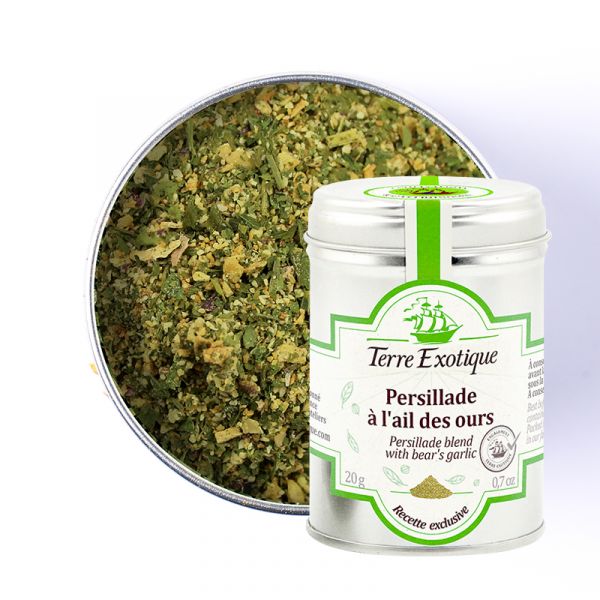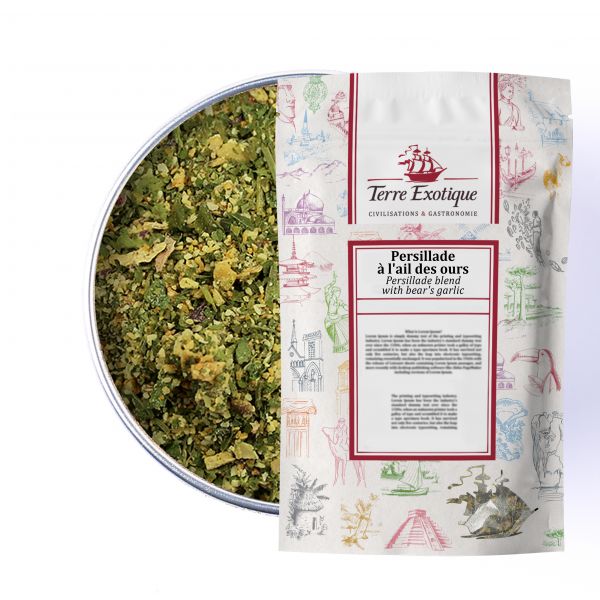





In what dishes to use garlic wild herb persillade?
Persillade is a real must-have, but with wild garlic, it adds an original note to a simple seasoning. We recommend sprinkling it on your grilled meats: tested and approved!
How to use garlic wild herb persillade?
Our recipe ideas for using garlic wild herb persillade in your cooking:
- Provencal-style tomatoes: sprinkle ½ teaspoon of garlic wild herb persillade on your tomatoes (find the complete recipe below);
- chicken in persillade: add 1 tablespoon of garlic wild herb persillade on your chicken before placing it in the oven;
- mushrooms in persillade: add 2 teaspoons of garlic wild herb persillade to your melted butter in a pan before adding your sliced mushrooms;
- medallions of potatoes in persillade: after boiling your potatoes, place them on a baking sheet and crush them with the bottom of a glass. Sprinkle 2 pinches of garlic wild herb persillade on top and add a knob of butter. Put everything in the oven;
- mussels in persillade: add 2 teaspoons of garlic wild herb persillade on your mussels during cooking.
Essential herbaceous notes
Persillade and its recognizable smell are synonymous with southern cuisine for many people. This wild garlic variant reinforces the garlicky flavors of classic persillade but also brings a herbaceous, soft and fresh note.
What is Terre Exotique garlic wild herb persillade?
The garlic wild herb persillade blend is composed of parsley, shallot, garlic, and wild garlic.
Parsley, whose botanical name is Petroselinum crispum or sativum, is a plant measuring between 30 and 80 centimeters in height.
This aromatic plant is part of the Apiaceae family, which also includes coriander, cumin, fennel, and carrot, for example. The Apiaceae are widespread in temperate regions and grow under a Mediterranean climate.
Garlic, whose botanical name is Allium sativum, comes from the Liliaceae family. This perennial plant is made up of a bulb formed of cloves wrapped in membranes. Garlic can grow up to one meter high.
Shallot is a bulbous plant belonging to the Amaryllidaceae family, which is cultivated as a condiment plant. The term refers to the bulb itself, which has been an integral part of French gastronomy for a long time. Shallots are harvested from late June to early August, once the foliage turns yellow and starts to fall.
Wild garlic, also called wild garlic or wood garlic, is a perennial herbaceous plant belonging to the Amaryllidaceae family like shallot. It is therefore a bulbous plant whose botanical name is Allium ursinum. Wild garlic gets its name because bears, at the end of their hibernation, search for this plant to purify themselves.
The history of persillade
In 1814, the minister and chief diplomat of King Louis XVIII, Talleyrand, asked his chef Marie-Antoine Carême, whose nickname was "the king of chefs and chef of kings", to cook snails for a dinner for Tsar Alexander I of Russia. A risky bet! Yet, the chef stuffed the snails with butter, garlic, and parsley before baking them in the oven. This dish, called "escargots à la bourguignonne", turned out to be a great success and became an emblem of French cuisine.
And what if we tried to prepare snails using persillade with wild garlic?
| Allergen | Sulfites / Sulphites |
|---|---|
| Native country | FRANCE |
| Ingredients | parsley (Europe), shallot, garlic (SULPHITES), bear's garlic (7.5 %). |
| TRACES EVENTUELLES D'ALLERGÈNES | céleri, sésame, moutarde, fruits à coques. |
 Français
Français 